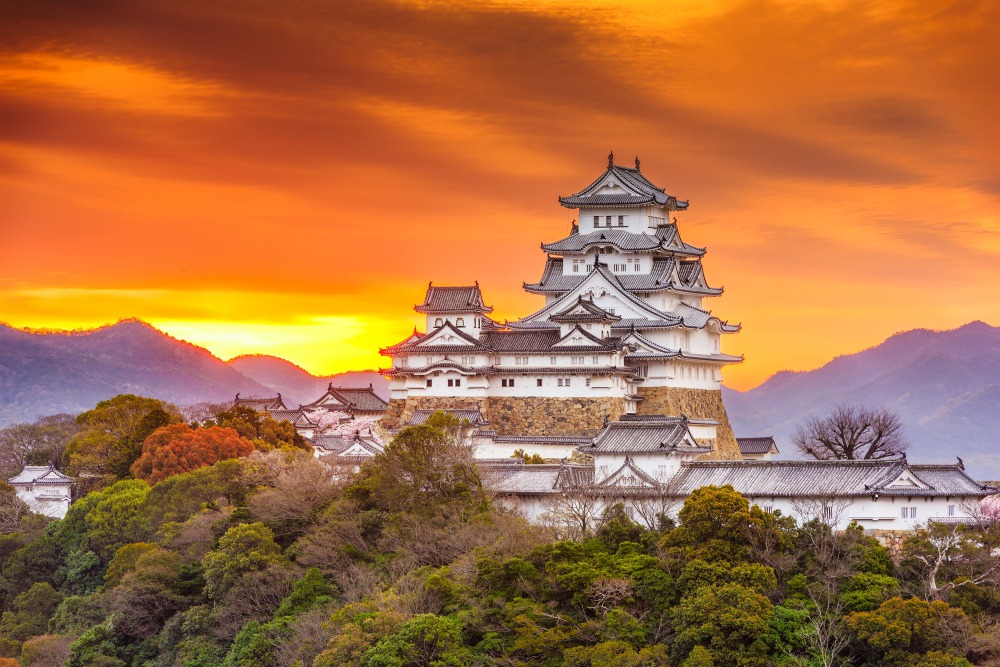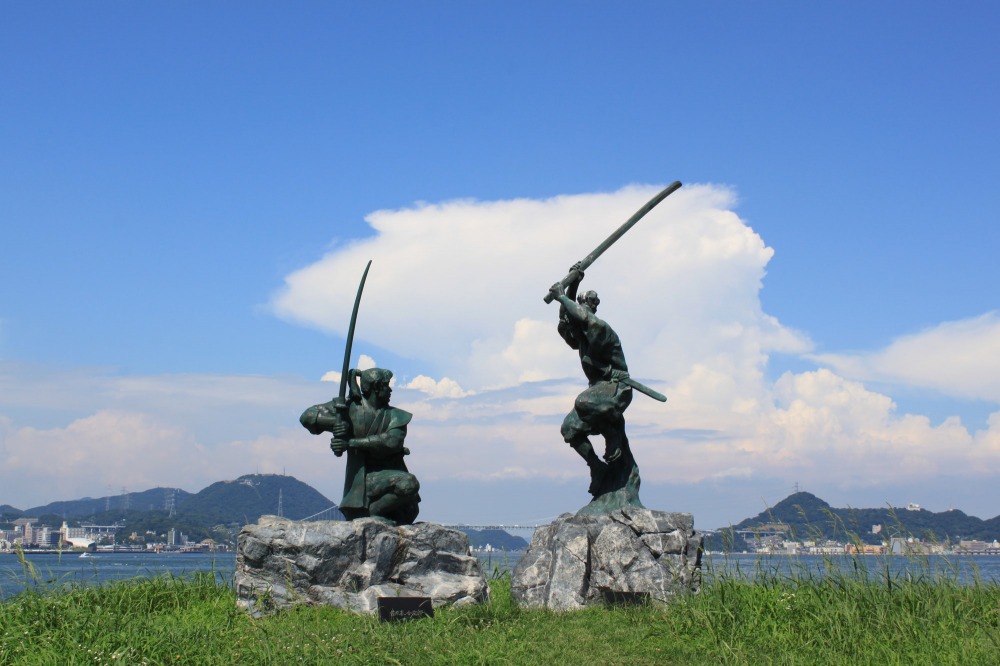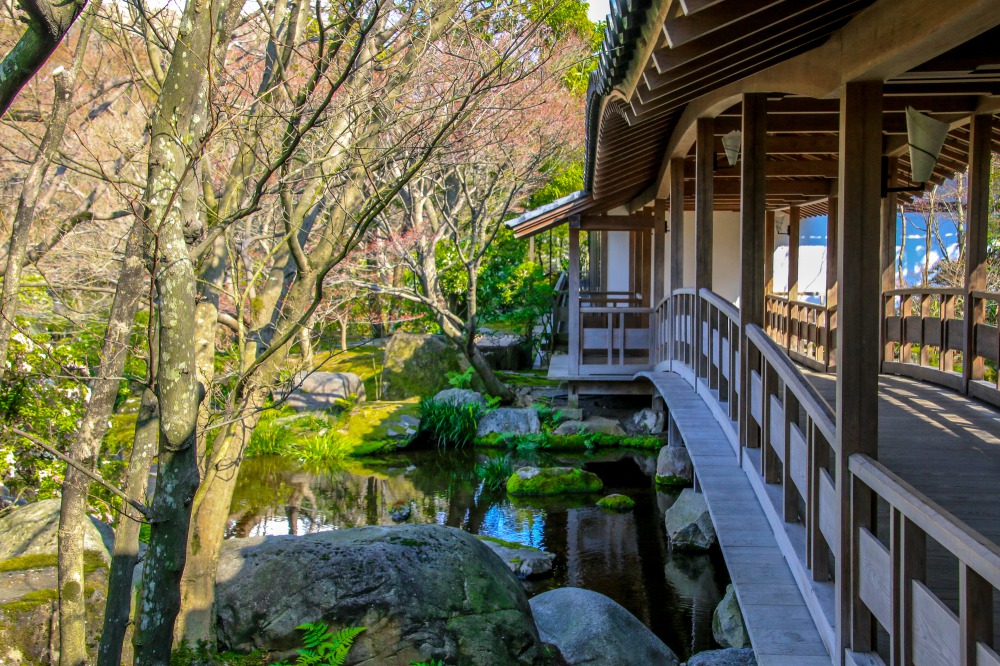Do you know the first place in Japan that was registered as a World Heritage Site?
It is Himeji Castle, which was designated as a World Heritage Site in 1993 along with Horyuji Temple in Nara Prefecture and other sites. Not only is Himeji Castle one of Japan's largest and most beautiful castles, it is also known as a masterpiece of wooden architecture, and many buildings in the castle complex have been designated as national treasures. The castle went under repairs in 2015, but was opened up to the public upon restoration. This article will introduce the attractions of Himeji Castle.
History of Himeji Castle: Who built it & When was it built?

The exterior of Himeji Castle
The older, conventional theory traced Himeji Castle's history back to the 1300s, to the construction of a defensive fortress by the warlord Akamatsu Norimura under the command of Prince Moriyoshi. The area was called Himeyama at the time, and the fortress was then expanded into a castle by Akamatsu Sadanori, the castle's first lord and Norimura's second son.
However, more recent historical discoveries stated otherwise. A certain set of historical documents were found referring to a castle in the Himeyama region as a "new castle of the Eiroku era (1558 - 1570)", and another document under the name of "Shomyoji Monjo" describing the existence of such a castle in 1561. Considering the implication that the castle had to be "new" as of the Eiroku era, the administration periods of the area's regional lords, Kuroda Shigetaka and his son, Mototaka (who would have had been responsible for the castle's construction), and various other factors, a current popular theory states that Himeji Castle must have first been built between 1555 and 1561.
Over its history, Himeji Castle has been governed by many military commanders. Ever since Toyotomi Hideyoshi unified the country during his time at the castle in 1580, Himeji Castle has been known as the “Shusse-jo” - "The Castle of Success".
One thing that sets Himeji Castle apart from others, is how throughout its long 400 years of history, it has survived the wars of the Sengoku Period (The Warring States Period), World War II, and several natural disasters. With the help of restoration and renovation efforts to support the aging castle, the beautiful white walls of Himeji Castle have overlooked its surrounding towns, all the way since they were built.
The 5 Must-see Spots at Himeji Castle
1. The Main Tower - "Tenshu"

the interconnecting Tenshu of Himeji Castle
The main highlight of Himeji Castle is the Daitenshu, the highest tower in the castle complex. The Daitenshu has an interconnected structure, and boasts a five-tiered structure that has one basement floor and six floors above ground. In addition, three kotenshu (small towers) stand interconnected with each other and the Daitenshu.
The Daitenshu of Himeji Castle is acclaimed as the best in Japan for its white exterior appearance, beautifully designed roof shape, and pair of big Shachihoko (Japanese imaginary creature with the head of a tiger and the body of a fish) statues settled on the roof. Himeji Castle stands on a mountain called Himeyama, so you can see the castle from various places in the city.
2. The Strongest of the Castle Gates - "Hishi Gate"

Hishi Gate
The complex of Himeji Castle has more than 10 gates. The largest of them is Hishi Gate. It retains the style of the Azuchi Momoyama Period, and is called Hishi Gate because the pillars that support the gate have a crest of "Hishi" on them. Visitors go through this gate, as It is the first gate seen from the entrance to the castle. We recommend you stop and look at the gate carefully.
3. The Garden past the Gates - "Nishinomaru"

Kesho Yagura in Nishinomaru
Nishinomaru is the garden you see on the left once you've gone through Hishi Gate. In the garden stands Musha Damari, a place where soldiers gathered before war during the Sengoku Period. In addition to the beautiful nature, the building called "Kesho Yagura" is also a must-see. It was built for Princess Sen, who married the famously handsome, Honda Tadahiro. It is believed that this place was the princess' break room.

Hyakken Hallway
In addition, Hyakken Hallway, also remains in the garden.
4. A Defensive Passageway - "Ninomaru"

Please watch your children so they won't get lost
Ninomaru is the space that extends on the other side of Ino Gate from the front of the Hishi Gate. The area that is full of buildings, gates and structure makes it hard for enemies to invade this area. Even if it were to be invaded, its complicated structure would make it easy to drive the enemies into narrow sites; you need to watch your children so they won't get lost.
5. A Spacious Photo Location - "Bizenmaru"
The extensive area in front of the Daitenshu is called "Bizenmaru." Originally, this area had the house of the castle architect, Ikeda Terumasa and his family, but the house burned down in a fire in the middle of the Meiji Period. Though only a large empty space is left in this area, it is one of the most popular spots in the castle complex.
A Castle of Legends! 2 Tales of Himeji Castle
Himeji Castle, whose long history dates back to the year 1300, has various anecdotes and legends from its long history. Here, you will see some famous examples of legends that have been passed on for a long time.

Beautiful sunset and Himeji Castle
Tale ① Okiku's Well
The well-known love tragedy "Banshu Sarayashiki" became popular as a Joruri (traditional Japanese narrative music) story and has been adopted as themes of Kabuki (classical Japanese dance drama) and Rakugo (form of Japanese verbal entertainment) since the Edo period. It is said that the well from this story is Okiku's Well in Himeji Castle.

Okiku's Well
In the days of the castle's ninth lord Kodera Norimoto, one of his vassals Aoyama Tessan planned to seize the castle. Another vassal of Norimoto noticed this scheme and sent his mistress Okiku to Tessan's castle as their maid to conduct investigations. Okiku succeeded in identifying the Aoyama Family's plan to assassinate Norimoto and was able to prevent this attempt.
However, when the family's vassal Chonotsubo Danjiro suspected that there was a spy in their castle, he searched through the entire castle and found out Okiku was the spy. Having been interested in Okiku, Danjiro asked her to marry him, threatening to reveal her espionage. Okiku firmly rejected his proposal, which made Danjiro angry. he then hid one of the ten plates that were the Aoyama Family's treasures and laid the blame on her. Legend has it that he blamed her to death in the end and threw her body into the well. It is said that from then on, people started hearing Okiku's voice, as she counted the number of the plates every night (there are different theories).
The well is believed to be the one to the south of Bizenmaru, which you see on your right after you go through Hishi Gate. Today, Okiku is enshrined in Junisho Shrine, which is about a 20-minute walk away from Himeji Castle.
Tale ② Miyamoto Musashi's Yokai Extermination
Around 1580, in the days when Kinoshita Iesada was the castle lord, the well-known sword master Miyamoto Musashi, was working anonymously as an Ashigaru-bugyo (infantry) in the Himeji area.

Statues of the duel between Miyamoto Musashi and Kojiro Sasaki on the Ganryu Island
At that time, rumor had it that Himeji Castle was haunted by Yokai (monsters from Japanese folklore). While people were scared, Musashi guarded the castle even at night with no fear. The rumor of his bravery reached a Karo (top-ranking samurai official); as a result, people found out that Musashi was a renowned master of martial arts, and he was ordered to exterminate Yokai.
At night, when Musashi entered the castle, the 3rd and 4th floors were surrounded by a large flame. There was an earthquake-like quake and noise. When Musashi put his hand on his sword, both the flame and quake stopped, and silence came back. Then, Musahshi continued to be on guard all throughout the night. When it became brighter outside, a beautiful princess appeared in front of Musashi, saying that she was Osakabe Myojin, a guardian deity of Himeji Castle. She thanked him for expelling Yokai and gave him a great sword by Go no Yoshihiro (there are different theories).
Himeji Castle's long history has passed many legends and anecdotes to the present day. If you read up on some of these legends beforehand, you might be able to imagine a better pictures of life back then as you visit the featured sites at the real-life Himeji Castle.
About Himeji Castle's Repair Work
Himeji Castle went thorough repair work called "the Major Repair Work of the Heisei Era," from October 2009 to March 2015. The repair work was mainly done to the external walls of the castle towers, the Shachihoko statues, and decorations on the roofs and other parts of the castle. In this article, you will also learn about "kawara (roof tiles)" which are unique to Himeji Castle. Also, an activity of "karawa making" is available, which makes your visit to Himeji Castle even more enjoyable.
Repair work and tiles

Shiromidai Park has replicas of the Shachihoko statues
Among various decorations, the most noteworthy are the roof tiles of Himeji Castle. Since clay of good quality is available in Funatsu-cho, Himeji City, Hyogo Prefecture, roof tiles have been manufactured actively since the 1800s. Tiles of Funatsu-cho were known as “Kanzaki Kawara” because it is located in the former Kanzaki District.

Himeji Castle under the Major Repair Work of the Heisei Era
To honor this background, roof tiles from Koyoseiga located in Funatsu-cho were used in the repair work. Traditional roof tiles such as Shachigawara (roof tiles in the form of Shachihoko) and Onigawara (rooftiles in the form of oni, a Japanese demon) were placed all over the castle complex, and Himeji Castle was "reborn" more beautifully and whiter.
Koyoseiga offers tours around the factory, where visitors can see the roof tiles used in the construction. With guidance about tiles from active artisans, you can learn about the tools used in the factory, through seeing and touching them.
Also, after the tour, you can try making roof tiles and clay crafting with the artisans. In tile crafting, you can make "Ibushigawara," a type of roof tile that is actually used for roofs. Also, in clay crafting, you can manually shape a Sachihoko or the face of an oni.
Your very own baked clay works are mailed to your house later on, and it serves for a perfect unique memory of your trip.
Enhance your Himeji Castle Visit! Apps & Guides
Here is some information about an online app and tourist guides that are essential to tour around Himeji Castle.
App: Himejijo Daihakken (Himeji Castle Great Discovery)
You should definitely download the official app to take with you on a tour around Himeji Castle. The app, "Himejijo Daihakken", is dedicated to Himeji Castle and offers guidance and shows exhibition using AR and CG.
If you hold up your smartphone at sites with an app sign, you can see animation or get trivia on the app.
The app has other gimmicks you won't know about until you actually use it. You can download it for free.
Tour guides available in many languages
In Himeji Castle, tour guides who speak Japanese and other languages provide detailed information including history of the castle. It is ¥2,000 to hire a Japanese-speaking guide. Guidance in other languages are provided free of charge by local volunteers. Neither type of guides require reservations. You can apply for the tour guide service at the reception of the castle.
Events at Himeji Castle
In Himeji Castle, a staple tourist spot in Himeji City, various seasonal events are held every year.
Himeji Castle Illumination Event

Illuminated Himeji Castle
Every year, illumination events are held from autumn to early winter. A fanciful atmosphere is produced not only around the Tenshu but also in the square of the castle complex. Please check the website for details including the dates and times.
Himeji Castle, known as "the White Egret Castle"

Cherry blossoms at Himeji Castle
Himeji Castle has been frequently called "the White Egret Castle," because of its beautiful white external appearance similar to an egret with its wings open. Himeji Castle is attracting attention again especially because the repair work is done. Only Himeji Castle and Nijo Castle in Kyoto are registered as World Heritage Sites of all the castles built during the Sengoku and Edo periods.
How about visiting the historic castle that has guarded the city of Himeji for hundreds of years?
Information
〒670-0012 68 Honmachi, Himeji, Hyogo Prefecture
079-285-1146 (Himeji Castle Management Office)
9:00 AM - 4:00 PM (The gate closes at 5:00 PM) *In the summer (April 27 - August 31): 9:00 AM - 5:00 PM (The gate closes at 6:00 PM)
December 29 & December 30
Adult (18+ years old): ¥1,000 Child (elementary, junior high or high school student): ¥300
How to go to Himeji Castle
Nearest station: Sanyo Himeji Station (JR Sanyo Line)
###Access from Kobe Station
JR Kobe Line Special Rapid / bound for Himeji
→ 【Himeji Station】→ 16-minute walk or Sinki bus/ bound for Oikedai 【Himeji-jo Otemon-mae】5-minute frim the bus stop
Access from Osaka Station
JR Kobe Line Special Rapid / bound for Himeji
→ 【Himeji Station】→ 16-minute walk or Sinki bus/ bound for Oikedai 【Himeji-jo Otemon-mae】5-minute frim the bus stop
Access from Itami Airport
Shinki Bus Airport Limousine Bus /bund for Himeji Station
→ 【Himeji Station】→ 16-minute walk or Sinki bus/ bound for Oikedai 【Himeji-jo Otemon-mae】5-minute frim the bus stop
Access from Kansai International Airport
Shinki Bus Airport Limousine Bus /bund for Himeji Station
→ 【Himeji Station】→ 16-minute walk or Sinki bus/ bound for Oikedai 【Himeji-jo Otemon-mae】5-minute frim the bus stop
Places to Visit near Himeji Castle
In addition to Himeji Castle, Himeji Park also has a variety of tourist attractions, such as zoos and art museums.
Koko-en Garden: A Picturesque Garden with a View of Himeji Castle

Koko-en Garden
An essential part of Himeji Park is the Koko-en Garden, which is located in the western part of the park. The garden park is popular since you can see the national treasure, Himeji Castle, and there are nine gardens with different themes within the premises.
Popular among them are "the Mansion Garden," where colored carp swim in a large pond, "Café Garden," where a café named Sojuan stands, and "Garden of Summer Trees," where you can enjoy leaves in beautiful colors in the fall.

The garden's overwhelmingly beautiful leaves in the autumn
Koko-en Garden boasts rich nature, and you can enjoy various plants in each season as well as seasonal views. In addition, Soujian offers matcha tea with sweets and is a perfect place to take a break while enjoying the garden view.
◆ Admission fee
< Individual ticket >
Adult (18 years old or older): ¥300
Elementary, junior high and high school student: ¥150
Toddlers: Free
< Combination ticket (Himeji Castle + Koko-en) >
Adult: ¥1,040
Elementary, junior high and high school student: ¥360
◆ Soju-an
Price (matcha tea and Japanese sweets): ¥500
.jpg)










_600x400.jpg)















_600x400.jpg)


